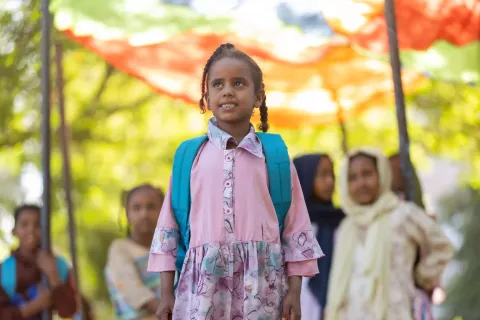Q and A: Why is it important to protect children affected by armed conflict
UNICEF Sudan Child Protection Specialist, Carin Atterby, answers five questions on the importance of strengthening the protection of children affected by armed conflict.

- Available in:
- English
- العربية
How do we classify children associated with armed conflict?
According to the Paris Principles, the definition of a child associated with an armed force or armed group refers to any person below 18 years of age who is or has been recruited into or used by an armed force or armed group in any capacity, including but not limited to children, boys and girls, used as combatants, cooks, porters, messengers, spies or for sexual purposes. It does not only refer to a child who is taking or has taken a direct part in hostilities.
A 100 Member States, including Sudan, have signed the Paris Principles.
Is it okay to say ‘child soldiers’?
It is more appropriate to use the term ’Children Associated with Armed Forces and Armed Groups’. This is because children are recruited into and used by armed forces and armed groups for many difference purposes, not only as combatants. Children are also used as combatants, cooks, porters, messengers, spies or for sexual purposes, etc.
This acknowledgment that children are used for many purposes have been crucial to how children access reintegration assistance once disengaged from armed actors. For example, if child protection actors only consider child combatants carrying weapons as recruited and in need of reintegration support, many children, and especially girls, would be excluded from such assistance whether intentionally or not. It is therefore important to broaden the understanding of children recruited and used to include all children associated with armed forces and armed groups.
What is the status of children associated with armed conflict in Sudan?
In the past decade, the United Nations has verified more than 400 children recruited and used by parties to conflict across Sudan. That translates into more than three children recruited and used each month between the years of 2011 and2020. Many of these children were adolescent boys in the Darfur states, South Kordofan, Blue Nile and Abyei.
As in many situations, children in Sudan joined armed forces and armed groups for many various and intertwined reasons. Some of those reasons include financial ones, to be able to support themselves and their families, safety and protection considerations, to be able to cover for their basic needs, to seek revenge, etc. There are many risk factors that increase a child’s vulnerability to recruitment and use including forced displacement and separation from caregivers and parents.
What are UNICEF and partners doing?
Preventing and responding to the needs of children affected by armed conflict is a core commitment of UNICEF. Together with its partners, UNICEF in Sudan engages with parties to conflict to halt and prevent grave child rights violations. For example, UNICEF and partners train armed forces and armed groups on child rights and child protection and raise their awareness on their national and international commitments to protect children in armed conflict. UNICEF also provides programmatic services to children affected by armed conflict, including educating children and their families of the dangers of Explosive Remnants of War (ERW) and providing victim assistance to children affected by Explosive Ordnance; providing services to survivors of sexual violence; supporting the reintegration back to civilian life of children associated with armed forces and armed groups; and supporting the strengthening of systems around children aimed to protect them including social services, community-based networks, families and caregivers .
What is CAAC?
CAAC refers to Children and Armed Conflict. It is a Security Council mandate that has the objective to strengthen the protection of children affected by armed conflict. The mandate includes key aspects such as monitoring and reporting on grave child rights violations, advocacy and dialogue with parties to conflict and programmatic response to children affected by armed conflict.
The CAAC mandates celebrates 25 years in 2022.



